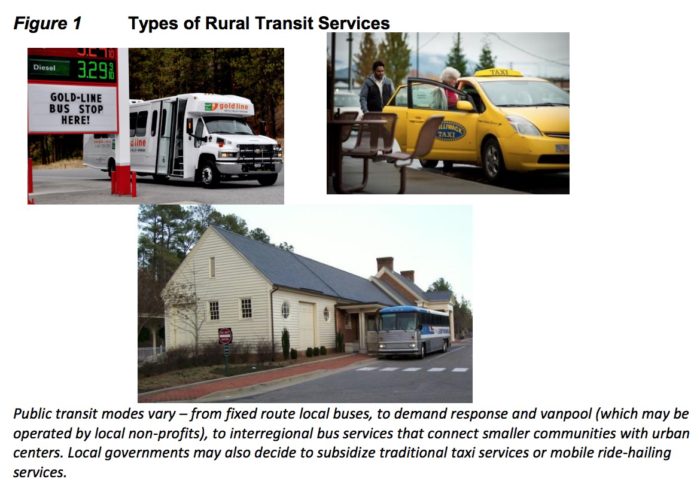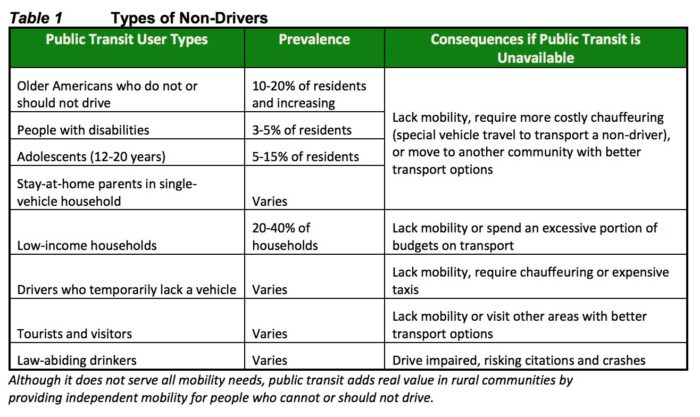AMERICAN PUBLIC TRANSPORTATION ASSOCIATION (APTA)
COMMUNITY TRANSPORTATION ASSOCIATION OF AMERICA (CTAA)
Rural and Small Town Public Transportation: Summary Points
- The number of rural and small town public transit agencies has increased over the past two decades to approximately 1,400 agencies (2014).
- America’s rural population is declining, but ridership has increased from 2007 to 2015. This equates to an 8.6 percent increase in per-capita rural ridership over the past 8 years, and a 7.8 percent increase in total rural ridership. For comparison, urban public transit ridership increased by 2.3 percent in the same time period.
- Rural demographics make public transit increasingly desired. Older Americans make up a larger portion of rural populations (17 percent) than in urban populations (13 percent).
- Rural residents with disabilities rely on public transit- they take about 50 percent more public transit trips than unimpaired people do.
- There are 2.9 million rural veterans, making up 33 percent of the veteran population enrolled in the VA health care system. Rural public transit can help them access needed services.
- Public transit can reduce the risk of road accidents. Rural residents travel about 33 percent more than urban residents, and although rural areas only make up 19 percent of the population, they account for around 49 percent of traffic fatalities.
- Rural poverty rates exceed urban poverty rates in all regions. Rural public transit can help reduce personal travel expenditures due to gas and other vehicle maintenance expenditures (rural households spend about 7 percentage points more of their budgets on transportation than urban households do).
- Public transit can help promote active lifestyles in rural communities struggling with health problems such as obesity, and can link people with healthcare services.
- Rural public transportation can be an important force in supporting local economies by connecting residents (especially non-drivers) with local businesses and job opportunities.
- Rural public transit spending per capita is lower than in urban areas. Increased local and federal investment can help address this.
Introduction
Rural communities and small towns have much to offer, including a sense of community, affordable housing and access to open space. However, many of these areas are currently experiencing population declines due to various demographic and economic trends. An aging population, industrial shifts, changing consumer preferences and diminishing local services have all contributed to rural stagnation.
Like people anywhere, rural and small town residents rely on transportation to access jobs, schools, medical facilities, retail shopping, recreation, social events and other services. This can be challenging in these areas because of lengthy travel distances and limited travel options, particularly for people with limited ability to drive.
While it is sometimes assumed that public transportation is only essential for large urban areas with significant traffic congestion, this report shows that public transportation can also play an important role in rural areas and small towns. Although public transit serves a minor portion of total rural travel, the trips that are provided are particularly valuable.
By examining current trends, this report reveals the increasingly critical connection between public transit and rural communities and small towns. This paper also looks at rural public transit cost efficiency, and describes successful examples of smaller community public transit programs.
Rural and Small Town Demographic Analysis
This section describes the various benefits that public transportation has on rural areas and small towns, and how demographics will affect future rural public transit demands.
Older Americans
Although many older Americans drive safely, as people age, particularly past 75 years, their driving ability tends to decline, as illustrated in Figure 2. By choice or necessity, many older Americans adjust their routines and rely on alternative transportation options.
A relatively large and growing portion of rural and small town residents are older Americans (figures 4 and 5). About 17 percent of rural residents are over 65 years of age- 5 percentage points more than the U.S. population overall (Werner 2011). Rural and small town census tracts contain 21 percent of the total U.S. population but approximately 25 percent of all older Americans, and 21 of the 25 “oldest” counties are rural (HAC 2014).
Surveys indicate that most older Americans want to “age in place”, that is, continue living in their current communities. To make this possible, rural communities and small towns need appropriate mobility options. The American Association of Retired Persons (AARP) report, Aging In Place: A State Survey of Livability Policies and Practices (Farber and Shinkle 2011) highlights the importance of providing suitable mobility options to allow aging residents to retain their independence. As Lydia Morken and Mildred Warner explain in their report, Planning for the Aging Population: Rural Responses to the Challenge (Morken and Warner 2011),
“Whether older adults can age in place hinges largely on transportation. Can they reach the services available to them, get to a routine doctor’s appointment, or attend a social event? Older adults’ diverse mobility needs present some of the most pressing challenges for rural communities. Most people will outlive their ability to drive, and many will face isolation when they can no longer get behind the wheel. Older adults in rural and suburban areas will feel this acutely as communities designed for the car offer few other transportation options.”
Compared with other geographic areas, rural communities have greater gaps in senior transportation services (NCST 2010). Serving seniors’ travel demands helps support local economic development. Rural communities that develop such services can attract and retain more seniors and the economic activity they generate.
People with Disabilities
Many people with temporary or long-term disabilities are limited in their ability to drive. As Americans age, it becomes more difficult for them to travel (as illustrated in Figure 6), in part because of medical conditions and disabilities, making community-based services essential.
Many people with disabilities who would previously have been institutionalized now live in regular homes in residential neighborhoods, reflecting the principle of community integration. This can provide a better quality of life and overall cost savings for the disabled community, and if successful, provides support services such as appropriate public transportation. Even if they live in automobile-owning households, people with disabilities often want public transit services so that they can live more independently and minimize the chauffeuring burdens they may impose on family members.
Many rural residents with disabilities rely on public transit. And, those with mobility impairments take about half as many daily trips as people without such conditions. However, residents with medical conditions take about 50 percent more trips on public transit than unimpaired people do (Table 2).
A 2016 survey taken in Ohio by the Ohio Colleges of Medicine Government Resource Center found that less than 37 percent of respondents had personal access to a vehicle. That resulted in 54 percent responding that they relied on rides from family or friends, and 30 percent saying that they relied on public and paratransit. More than 50 percent noted that they routinely had to wait more than 30 minutes or more for service and that they had to travel for a long time period. Since most rural communities offer relatively limited public transit services, there is considerable latent demand. Many rural residents with disabilities would use public transit more if additional service were available.
Public transit is particularly important for people with both disabilities and low incomes. Figure 7 displays the percentage of older Americans (over 65 years) who have disabilities and live in low-Income households (below 150 percent of poverty threshold).
Download full version (PDF): Public Transportation’s Impact on Rural and Small Towns
About the American Public Transportation Association (APTA)
www.apta.com
APTA is the leading force in advancing public transportation. Mission Statement: To strengthen and improve public transportation, APTA serves and leads its diverse membership through advocacy, innovation and information sharing. APTA and its members and staff work to ensure that public transportation is available and accessible for all Americans in communities across the country.
About the Community Transportation Association of America (CTAA)
www.ctaa.org
The Community Transportation Association of America (CTAA) and its members believe that mobility is a basic human right. From work and education to life-sustaining health care and human services programs to shopping and visiting with family and friends, mobility directly impacts quality of life.
Tags: American Public Transportation Association, APTA, Community Transportation Association of America, CTAA, Rural, Small Town Public Transportation, Small Towns








 RSS Feed
RSS Feed